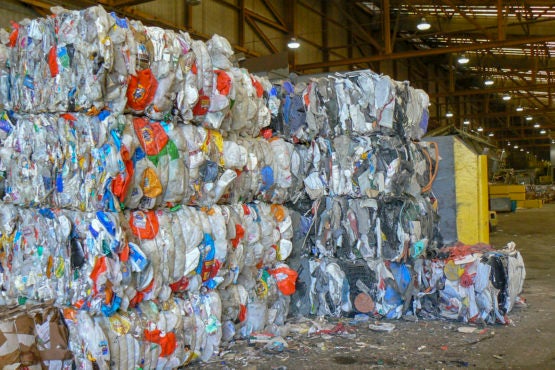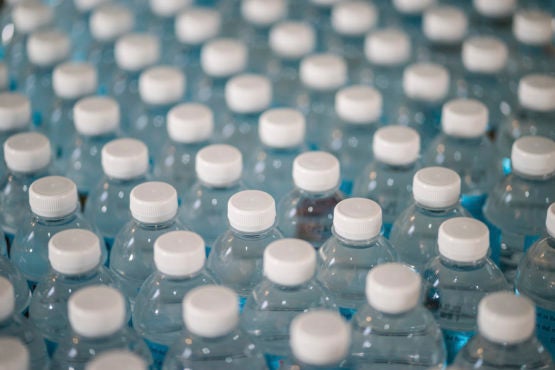Stanford experts discuss challenges and opportunities in disposing of waste
Recycling is becoming harder and more expensive in the U.S. and policymakers are increasingly seeking solutions to mounting trash. Stanford experts are reassessing how we create and dispose of waste.
Waste ain’t what it used to be. Since China largely closed the door to imported garbage last year, recycling costs have increased considerably and programs have disappeared or scaled back in communities across the United States. The shift creates an opportunity for reassessing how we create and dispose of waste.

Recycling of conventional plastics, such as these at a waste processing center in San Francisco, typically leads to a decline in value compared to virgin plastic. (Image credit: Walter Parenteau / Flickr)
The issue is urgent. Plastic, a particularly vexing example, is in 94 percent of tap water samples in the U.S. and in nearly every brand of bottled water, according to one study. Plastics, and the chemicals that attach themselves to plastics in the water, can cause cancer, genetic disruptions and other ill effects. Some states are taking action. Bills moving through California’s Legislature would mandate reducing, composting or recycling 75 percent of single-use packaging by 2030, reducing solid waste generation, fostering domestic recycling markets and even eliminating paper receipts.
Craig Criddle, a professor of civil and environmental engineering, and Abhay Jain, an MBA candidate at Stanford’s Graduate School of Business, discuss waste challenges and opportunities below. Criddle has evaluated the use of microorganisms to biodegrade plastic materials and to synthesize biodegradable bioplastics – plastics derived from renewable sources – from waste feedstocks. Jain studies waste management and started a recyclable waste collection company in India.
What makes recycling so hard to do profitably?
Criddle: Recycling of conventional plastics typically leads to downcycling and a decline in the value of the recycled plastic compared to virgin plastic. People are often befuddled by recycling bins because the labeling is inconsistent and confusing. As a result, recycle streams become contaminated. Recycled plastics need a price advantage over virgin plastics, but virgin plastics are quite cheap. They are typically produced from low-cost fossil carbon feedstocks, and their manufacturing has been optimized at large scale.
Jain: There are many reasons which vary significantly based on location. However, some reasons can be seen in most markets. The overall recycled product market is fragmented or nonexistent, which makes it difficult to create and capture value from these products. In addition, the costs of complying with emissions and disposal regulations and processing unsegregated waste drive up recycling costs. Sometimes, there are local limitations in technology and finances. Also, because waste for the most part is out of sight and out of mind, there is limited regulatory push to improve conditions.
Are there any countries we should look to for inspiration on dealing with waste?
Criddle: The Germans have a simple color-coded trash collection system and have adopted a pro-recycling ethic. Recycling is a source of pride, a kind of national pastime. Bioplastics are getting a boost because the German government has recognized bio-based materials as a viable packaging solution and issued a call for projects on bio-based packaging.
Jain: Germany and Sweden come to mind. It is a combination of policies such as a Green Dot packaging policy [a global trademark that signifies a manufacturer has made a financial contribution to a packaging recovery organization], technology solutions and general public education. The focus spans everything from reduced waste generation and better waste segregation to continuous education.
What can we do in the short term as a bridge to more dramatic solutions, such as phasing out single-use plastic or designing self-destructing plastics?
Criddle: We need to improve labeling and sorting to prevent contamination. People also need to learn that biodegradable bioplastics should be composted or digested, not recycled with conventional plastics.

Unlike conventional synthetic plastics, such as these plastic water bottles, plastics derived from renewable sources are compostable and biodegrade like food. Some can even be reused as healthy animal feed supplements. (Image credit: Jonathan Chng / Unsplash)
Jain: We should restrict usage of difficult to recycle, non-environmentally friendly and limited-use materials, such as single-use plastic. We should encourage use of eco-friendly materials, such as paper straws, and governments should provide incentives, such as paying people for bringing clean plastic bags to drop-off sites.
What are some promising long-term solutions to our seeming addiction to single-use plastic and waste in general?
Criddle: We need to plan for circular economies. This means that products need to be designed for disassembly at end-of-life. If we are going to continue to use single-use plastics, then these materials should be biodegradable in whatever environments they enter at end-of-life.
Jain: The holy grail of waste management will be an economical way to segregate waste. We also need new technologies to recycle specialized groups of waste, such as e-waste [hazardous electronic waste]. If we are not careful, the world will soon have heaps of lithium ion batteries that will poison the environment. Lastly, we need to have good amounts of localization of each solution. This is a big challenge, but also an opportunity because the wheel needs to be reinvented in every country and region.
Do you foresee any major economic opportunities in these short-term and long-term changes?
Criddle: I am optimistic about bioplastics. Investing in them will have major long-term societal benefits. Unlike conventional synthetic plastics, which persist in nature, bioplastics are compostable and biodegrade like food. A classic example is polyhydroxybutyrate, or PHB. Many bacteria store PHB as tiny granules that they then use as a source of carbon and energy. PHB can also be beneficial to animal health. When given as a feed supplement to aquatic animals, such as fish, crabs and shrimp, it can ward off infection.
For PHB and other similar bioplastics to compete financially with conventional non-degradable plastics, about a 60 percent decrease in cost is needed. Roughly 40 percent of the cost of bioplastics is in the feedstock – typically sugars or plant oils. With use of cheaper feedstocks, production costs will decrease and bioplastics will become more competitive. Examples of cheap feedstocks are food wastes, biogas methane, carbon dioxide and renewable hydrogen. Bioplastic costs will also decrease as production is scaled up due to economies of scale. This could happen at large biorefineries where bioplastics are co-products or at decentralized locations, perhaps in connection with wastewater treatment plants or landfills. Also, 3D printing could drive decentralized production of tailored bioplastics.
What are the prospects for passing related laws at the state and federal level? What are the primary obstacles?
Criddle: Laws and policies are needed that incentivize innovation by encouraging development of biomaterials and additives that are biodegradable in critical environments, are nontoxic and don’t accumulate in food chains. Opposition can be expected from companies that have invested heavily in the manufacturing of conventional plastics and from plastic recyclers concerned that bioplastics will contaminate conventional plastic recycle streams.
Is there any way to incentivize these changes for consumers and/or industry?
Criddle: A tax on conventional single-use plastics would lead companies to pass on the higher costs to customers, decreasing demand for conventional plastics and encouraging companies to seek alternatives. Funds from such a tax could support plastic cleanup efforts on coastlines, recycling facilities, and research and development of biodegradable alternatives.
